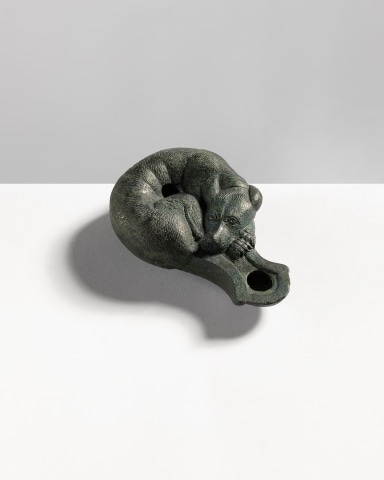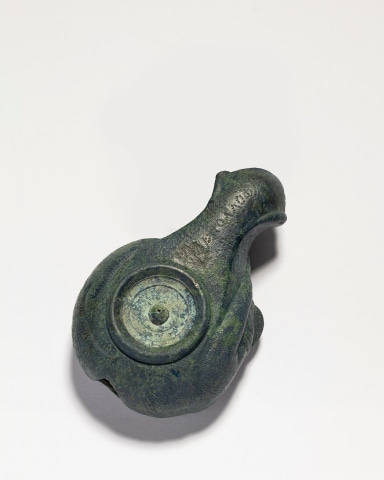This rare and highly sculptural lamp form, showing a dog curled up with its head resting on its front paws, features a three-line inscription on the underside of the wick projection, with the middle line possibly identifying the maker as Apollodos. The motif of a sleeping dog, popular in Roman decorative art, symbolised loyalty, reliability, and domestic guardianship. The expression on the dog’s face, the naturalistic curl of its body, the collar, the character of the eyes, the finely detailed paws, and the stippled texture of the fur are all rendered with notable skill. The wick projection flares outwards creating concave straight sides, the base is circular and raised on a foot, an air hole around which the body of the dog is curled. The handle, originally cast separately and soldered to the main body, is now missing, and has left a large hole at the back where it was attached. .
A close comparison can be made with a lamp in the British Museum, which depicts a collared mastiff or hunting hound resting on its paws and is said to have come from Crete. Another closely related piece in the Museum of Fine Arts, Boston, shows a greyhound curled up with a puppy, said to originate from Alexandria.
Provenance
V. Rosenbaum, Ascona, SwitzerlandToufique Arakji, London, UK; acquired from the above in 1971
Private collection V.A., Vienna, Austria; acquired from the above 9th September 1983
Private collection, London, UK; acquired from the above
Literature
For an almost identical design compare D.M. Bailey, A Catalogue of the Lamps in the British Museum, Volume IV: Lamps of Metal and Stone, and Lampstands (London: British Museum Press, 1996), p.63, no.Q3595Also compare M. Comstock and C. Vermeule, Greek, Etruscan & Roman Bronzes in the Museum of Fine Arts (Boston, 1971), p.347, no.487



